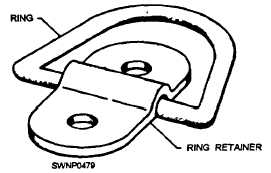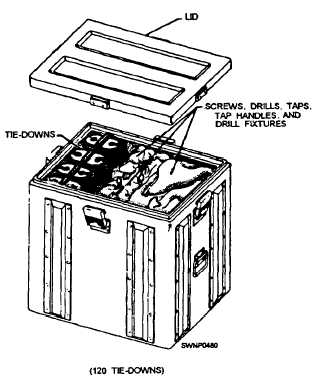between the runway and the taxiway is between 1 and 2 inches. Place a 90-degree connector in position, as shown in figure 11-26. Using a sledge hammer and a wooden block, drive it into position. The most efficient method is to drive the 90-degree connectors from either edge toward the center of the taxiway. Place a mark at or near the midpoint of the 12-foot length of the mat. Drive the first connector to this mark. The positions of the remaining 90-degree connectors are then automatically established. Care must be maintained while driving the connectors not to allow debris to be scooped up by the forward edges of the connectors.
INSTALLATION OF TIE-DOWNS. - The-downs are provided for aircraft anchorage. (See fig. 11-27.) They are shipped in a package or container, as shown in figure 11-28. An individual container contains 120 tie-downs, plus the screws, drilling, and tapping equipment necessary to install the tie-downs.
When tie-downs are to be installed, start by drilling and tapping the AM-2 matting on the prongs-down connector. Drill two holes for each tie-down ring retainer, using tools from the tie-down container. The procedure for drilling is as follows:
1. Secure the sleeve, 412131-1, to the 5/16-inch drill with the setscrew, using the drill fixture, 509044-1, as shown in operation 1, figure 11-29. Orient the sleeve to ensure seating of the setscrew on the body diameter of the drill.
2. Position the drill fixture, as shown in operation 2 (fig. 11-29), and drill one hole, as shown. Proper depth is obtained when the sleeve contacts the bushing.
3. Insert the pilot, 4121301, through the drill bushing into the drilled hole, and drill the second hole, as shown in operation 3 (fig. 11-29).

Figure 11-27. - Tiedown

Figure 11-28. - Tie-down container.
4. Tap two holes 3/8 inch, 16 threads per inch, unified national coarse class 3B fit. Finish with the bottom tap to obtain 9/16-inch minimum full-thread length.
5. Store the sleeve and the pilot in the holes provided and secure with setscrews.
After the drilling is completed, secure the ring retainer with two socket head screws.
PARKING AND STORAGE AREAS. - The parking and storage areas should be installed next. Mats and locking bars are installed in the same manner as the runway and taxi ways, except that the staggered joint pattern is not mandatory. This means that the area can be built up in any random pattern and that all leftover half-length or full-length mats can be used. The 90-degree connectors should be installed between these parking and storage areas and taxiways according to the procedure outlined earlier. Install tie-downs on the matting in these areas, as shown in figure 11-30.
BLAST DEFLECTOR INSTALLATION. - To shield the ground area around taxiways and parking areas from the blast effects from aircraft, install blast deflectors as required. Assemble blast deflector adapters to the boundaries of matting that will be
Continue Reading